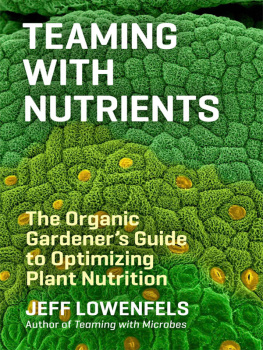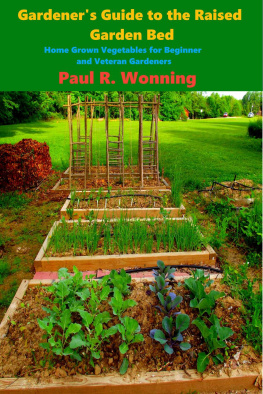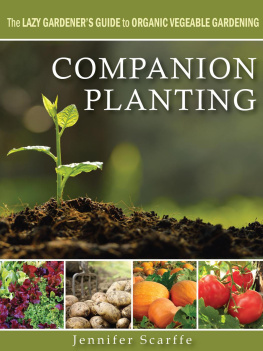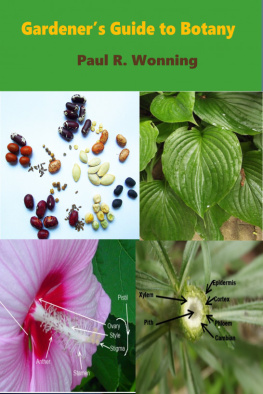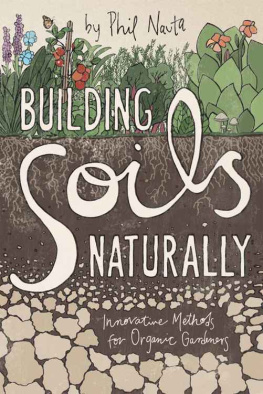
PRAISE FOR TEAMING WITH MICROBES BY JEFF LOWENFELS
Digs into soil in a most enlightening and entertaining way.
Dallas Morning News
Should be required reading for everyone lucky enough to own a piece of land.
Seattle Post-Intelligencer
Required reading for all serious gardeners.
Miami Herald
One heck of a good book.
The Oregonian
A very helpful source.
Sacramento Bee
A must read for any gardener looking to create a sustainable, healthy garden without chemicals.
Detroit News
A breakthrough book for the field of organic gardening. No comprehensive horticultural library should be without it.
American Gardener
This intense little book may well change the way you garden.
St. Louis Post-Dispatch
Sure to gain that well-thumbed look that any good garden book acquires as it is referred to repeatedly over the years.
Pacific Horticulture

TEAMING WITH NUTRIENTS
The Organic Gardeners Guide to Optimizing Plant Nutrition
JEFF LOWENFELS
TIMBER PRESS
Portland London
Frontispiece: Scanning electron micrograph of root hairs developing on a radish during seed germination
Photo and illustration credits appear on .
Copyright 2013 by Jeff Lowenfels. All rights reserved.
Published in 2013 by Timber Press, Inc.
The Haseltine Building
133 S.W. Second Avenue, Suite 450
Portland, Oregon 97204-3527
timberpress.com
2 The Quadrant
135 Salusbury Road
London NW6 6RJ
timberpress.co.uk
Printed in China
Book design by Susan Applegate
Composition and layout by Holly McGuire
Library of Congress Cataloging-in-Publication Data
Lowenfels, Jeff.
Teaming with nutrients: the organic gardeners guide to optimizing plant nutrition/Jeff Lowenfels.1st ed.
p. cm.
Includes index.
ISBN 978-1-60469-314-0
1. PlantsNutrition. 2. Plant nutrients. 3. Organic fertilizers. I. Title. II. Title: Organic gardeners guide to optimizing plant nutrition.
QK867.L87 2013
575.76dc23
2012033926
A catalog record for this book is also available from the British Library.
CONTENTS

FOREWORD
U NLESS YOURE a scientist who deals with mycorrhizae, youve probably never given much thought to how plants eat. Most gardeners think that growing a good tomato is all about photosynthesis and mixing in some nitrogen, phosphorus, and potassium (NPK). Jeff Lowenfels shows how wrong this assumption is.
This new book is the perfect companion to Jeffs first book, Teaming with Microbes: The Organic Gardeners Guide to the Soil Food Web, which deftly explains the all-important workings of the soil food web in delivering nutrients to plants. Now you can learn what plants do with these nutrients, how they get them inside their roots, and what happens to nutrients once they are in the plant.
Ive studied the science of how plants take in nutrients for most of my career. Its taken a lot of chemistry and biology to get me to where I am today. I only wish Id had this book as a much younger man just starting out in plant science and mycologyit would have saved me a lot of time and painful learning. Jeff has the knack of being able to explain complicated science in ways that are instantly understandable and even enjoyable. He holds your hand in the rough spots, walks you through the science, and then takes off once he knows youve grasped the concepts.
Jeffs book is as timely as it is informative. Too many gardeners think they are taking the modern path by blindly pouring on synthetic NPK fertilizer in accordance with a picture on the label or an ad on television. We let chemistry take over. We know little about what were doing, but we do it anyway. The result has been an alarming spike in phosphorus and nitrogen pollution.
NPK gardeners owe their practice to the great scientist Justus Von Liebig, the father of artificial fertilizers. What most dont know is that later in his life Von Liebig acknowledged a grave mistake in relying only on chemistry. In fact, he saw the negative impacts of artificial fertilizers on life in the soil in his own vegetable garden and thereafter preferred organic matter to the inorganic chemical fertilizers he invented. To quote Von Liebig, After I learned the reason why my fertilizers werent effective in the proper way, I was like a person that received a new life. Understanding how nutrients work will make us all see the light and ultimately make us better gardeners with more sustainable gardens.
I work with gardeners around the world. No matter their language, culture, or age, the story is always the same: all gardeners want to be successful. The good ones are those who learn as much they can about how plants function because they know this information will allow them to counter what they cant control. I am quite sure the information in this book will greatly add to any gardeners knowledge base and allow him or her to more perfectly balance those factors that cant be controlled.
How plants eatits about time we all learned.
Dr. Mike Amaranthus
Chief Scientist and President, Mycorrhizal Applications, Inc.
ACKNOWLEDGMENTS
T HERE ARE two people who must be acknowledged. The first is Judith Hoersting, my best friend and wife, who shared with me cellular biology, chemistry, essential nutrients, my MacBook, and the Portland library for a year while I got this out of my system. The second is Lisa D. Brousseau, who appeared out of nowhere and edited this book into shape. She kept the story on track; provided useful insights, corrections, and suggestions; and suffered for having to work with the worst proofreader in the history of the written word.
I sometimes think that never blows so red The Rose as where some buried Caesar bled; That every Hyacinth the Garden wears Dropt in her Lap from some once lovely Head.
Omar Khayyam
Eleventh-century Persian astronomer-poet
INTRODUCTION
H OW DO plants eat? I am pretty sure this is an age-old question. It probably came up 10,000 years ago after some early gardener noticed that rotting fish did wonders for plants. The observation that ones urine had a beneficial impact on plants could not be missed, either. These and other natural fertilizers not mentioned in public helped trigger the Neolithic Revolution, the transition from hunter-gatherer to farmer-gardener. Even in ancient times, feeding an ever-growing population required horticultural advances. The Aztec and Mayan civilizations, for example, were all about growing food to support burgeoning populations. They offered their gods sacrificial blood to ensure a good harvest. Perhaps this practice arose from their observation that soil bloodied from butchering an animal or as a result of some mortal blow during a heated battle grew better plants.
I come from a long line of natural fertilizer users. My grandfather and dad taught me to bury the uneatable, bony fish we used to catch every summer under roses and tomatoes. We had a horse for a while, too, and chickens, geese, ducks, and rabbits. We knew about the wonders of manure. I wont go into my use of urine as a fertilizer, but with three boys growing up on eight acres, you can bet it was applied to all manner of plants liberally, with varying impacts on the plants. Today, gardeners use homemade and commercial fertilizers, composts, and mulches. Many simply follow the directions with little or no thought about what those powders and liquids really do. Were just glad they do it.
Next page
